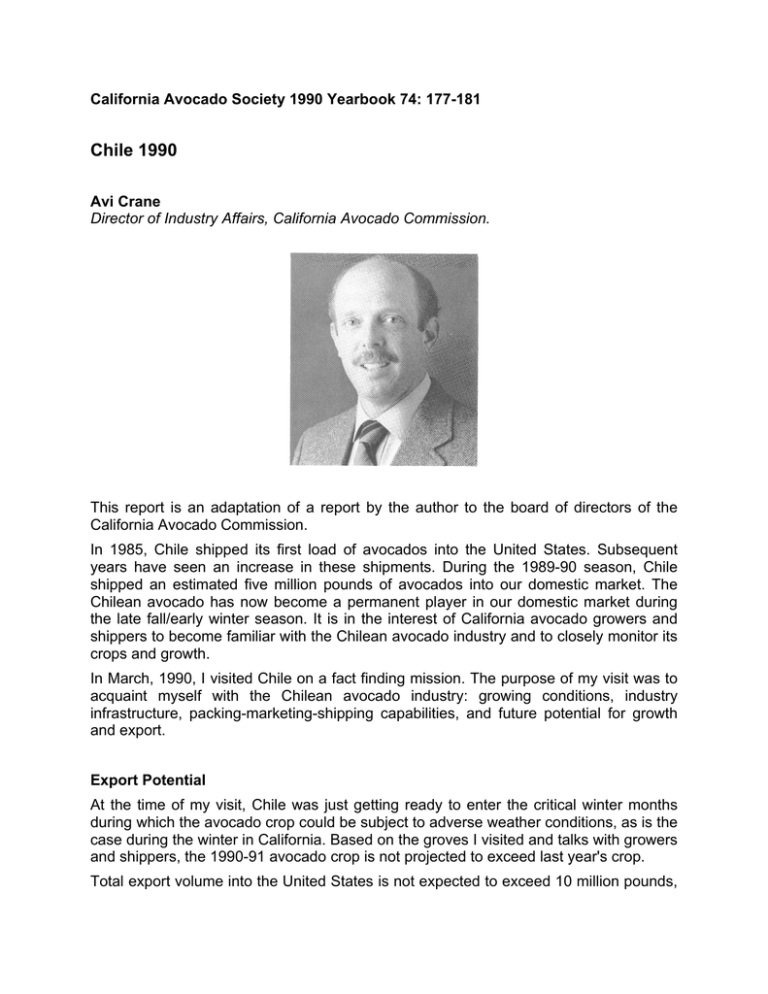Chile 1990
advertisement

California Avocado Society 1990 Yearbook 74: 177-181 Chile 1990 Avi Crane Director of Industry Affairs, California Avocado Commission. This report is an adaptation of a report by the author to the board of directors of the California Avocado Commission. In 1985, Chile shipped its first load of avocados into the United States. Subsequent years have seen an increase in these shipments. During the 1989-90 season, Chile shipped an estimated five million pounds of avocados into our domestic market. The Chilean avocado has now become a permanent player in our domestic market during the late fall/early winter season. It is in the interest of California avocado growers and shippers to become familiar with the Chilean avocado industry and to closely monitor its crops and growth. In March, 1990, I visited Chile on a fact finding mission. The purpose of my visit was to acquaint myself with the Chilean avocado industry: growing conditions, industry infrastructure, packing-marketing-shipping capabilities, and future potential for growth and export. Export Potential At the time of my visit, Chile was just getting ready to enter the critical winter months during which the avocado crop could be subject to adverse weather conditions, as is the case during the winter in California. Based on the groves I visited and talks with growers and shippers, the 1990-91 avocado crop is not projected to exceed last year's crop. Total export volume into the United States is not expected to exceed 10 million pounds, despite the expected low volume/high prices during the "window" period in the U.S. market. The reasons for this are as follows: 1. Hass is the primary export variety from Chile. At 34% of the total acreage, the '89-90 Chilean Hass crop is not expected to exceed 24 million pounds. 2. During the "window" period of September-October, the Chilean growers will not have an abundant supply of large size Hass for export.(By November, however, all sizes are expected to reach maturity.) 3. Even to reach the expected Hass export volume, Chile would need to harvest 30% of their Hass crop during their early season. 4. If U. S. domestic production is below $25 F.O.B. and comparable to the European price, Chilean growers are more likely to send fruit to Europe rather than risk sending to the U. S. market which is perceived as unstable. 5. Small quantities of Chilean Fuerte will arrive in May and June. This volume is expected to increase in early summer when California supplies begin to decrease. General Observations High avocado consumption (3.5 kilos per capita annually) assures a favorable local market. Low cost of local sales/consumption. marketing, high cost of export encourages domestic Irrigation costs are very low and many groves on flatland are irrigated by furrow. Plantings on slopes use drip. Labor costs are low (approximately $4 to $7 per day). Growers are greatly concerned that new government will reverse the previous "hands off" approach to agriculture. U.S. domestic F.O.B. price needs to be above $18 (25-lb. lug) before Chilean avocado growers will attempt export to the U. S. Packing and cooling technologies in Chile are similar to those in California. Port facilities and shipping technology are equal to any I have seen elsewhere in the world. Chile is a very capable world agriculture exporter. Acreage and Yields Production has increased during the past decade as new trees have come into production. It was apparent to me that strong European and U. S. markets over the past three years have encouraged new plantings. Therefore, an increase in production is projected. Varieties Most new plantings are of the Hass variety and future yields will show an increase in the percentage of Hass fruit. Production Aspects Diseases and Pests The single most important economic problem is Phytophthora cinnamomi. They have found trees that can survive six to eight years with the disease. Biological control is very successful in Chile due to the protection the Andes mountains provide against any pest infestation. I saw many healthy groves with little or no leaf damage from pests. Irrigation Much of the older groves use furrow irrigation. New groves, including those on hillsides, use drip irrigation. I found many growers have invested in extensive drainage systems. Research As far as I was able to ascertain, no industry-funded research program exists in Chile for avocados. The Catholic University of Valparaiso does do some limited projects on avocados and maintains industry statistics. The main reason given to me for this is that growing conditions in Chile for avocados are very similar to those in California. Cultural practices used in California are known to the Chilean grower. While they claim that they do not need to duplicate California research due to this similarity, I am convinced that, with time, they will find local problems that will necessitate some local research—such as, in pest management. Current research projects are concerned with fertilization (Fe and B), planting distances, and shipping and storage. Avocado Industry Structure According to my information, no central avocado association exists in Chile. The Association of Chilean Exporters provides support to the various commodities exporting fruit, including avocados. ProChile is a government agency charged with promoting Chilean produce throughout the world. Update - January 1991 The estimate of 1989-90 Chilean exports to the United States given in the early part of this report proved to be conservative. Due to a severe heat wave, the marketable 198990 California avocado crop was the smallest in ten years. As a result, the "window" for Chile in the fall of 1990 was extended. Attracted by the average F.O.B. price for California fruit of ±$50, Chile exported over 16 million pounds of avocados to the United States.


